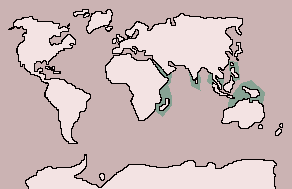Dugong

| Class: Mammalia:
Mammals |
Diet: Seaweed |
| Order:
Dugongs, Manatees |
| Size:
up to 3 m (9 3/4 ft) |
| Family: Dugongidae:
Dugong |
Conservation Status:
Vulnerable |
| Scientific Name: Dugong
dugon |
Habitat: coastal
waters |
| Range:
Coast of Eastern Africa, Indian Ocean, Red Sea to Northern Australia |
 The
dugong is a large, but streamlined animal, identified by its tail, which
has a crescent-shaped fluke. Its head is heavy, with a fleshy, partially
divided snout. The male has two tusks formed from the incisor teeth, but
these are often barely visible under the fleshy lips. A shy, solitary animal,
the dugong leads a sedentary life, lying on the seabed for much of the
time and only rising to the surface to breathe every couple of minutes.
Its nostrils are placed on the upper surface of the muzzle, so the dugong
can breathe, while remaining almost submerged. Seaweed and sea grass are
its main foods. Little is known of the dugong's reproductive habits,
but the gestation is thought to be about a year. The single young is born
in the water and is helped to the surface by its mother. The
dugong is a large, but streamlined animal, identified by its tail, which
has a crescent-shaped fluke. Its head is heavy, with a fleshy, partially
divided snout. The male has two tusks formed from the incisor teeth, but
these are often barely visible under the fleshy lips. A shy, solitary animal,
the dugong leads a sedentary life, lying on the seabed for much of the
time and only rising to the surface to breathe every couple of minutes.
Its nostrils are placed on the upper surface of the muzzle, so the dugong
can breathe, while remaining almost submerged. Seaweed and sea grass are
its main foods. Little is known of the dugong's reproductive habits,
but the gestation is thought to be about a year. The single young is born
in the water and is helped to the surface by its mother.

  
|
